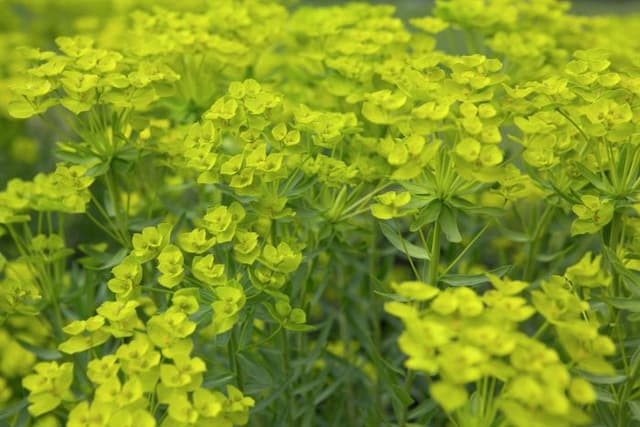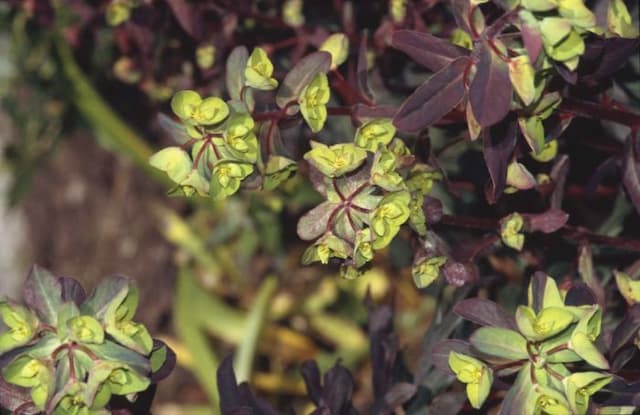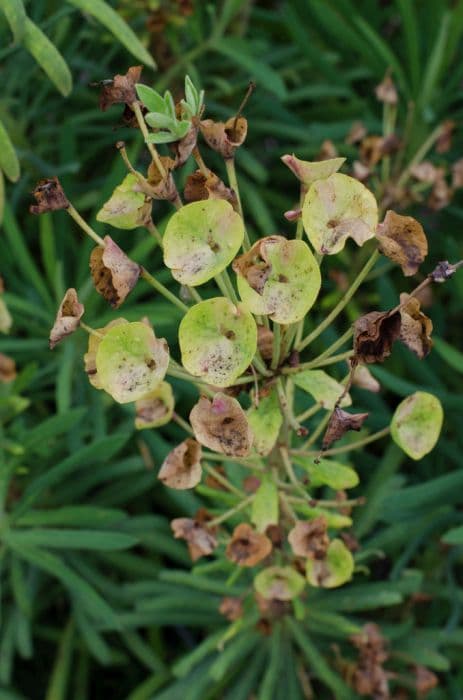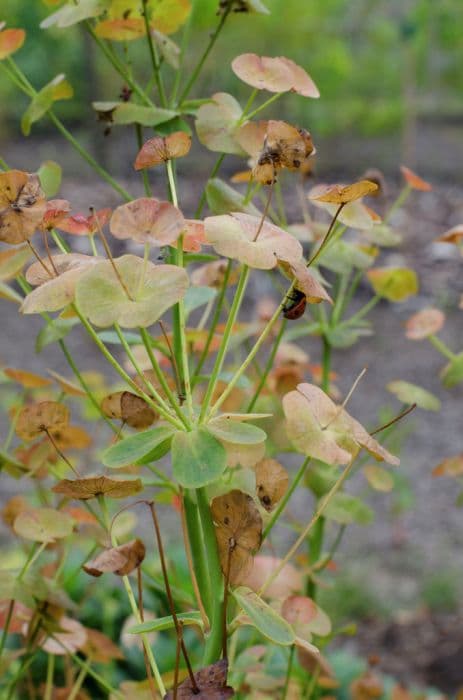Castor bean Ricinus communis 'New Zealand Black'

ABOUT
Ricinus communis 'New Zealand Black', commonly known as the castor bean plant, is striking for its bold and dramatic appearance. The plant is characterized by its deep purple to almost black foliage that resembles large, palmate leaves with serrated edges. This deep, dark coloration sets it apart from other garden plants and makes it a distinctive choice for adding visual interest. The leaves are glossy, with a leathery texture, and are supported by equally dark stems, which enhance the plant's overall beauty. When sunlight shines through the foliage, it can highlight the rich coloration and create an attractive play of light and shadow. Flowering on the castor bean plant may not be its most notable feature, but it does produce clusters of small, inconspicuous flowers. The flowers oftentimes blend into the foliage due to the similarity in color. However, these can give way to spiky seed pods that are also darkly colored and can be intriguing elements in the plant’s overall appearance. The overall visual impression of Ricinus communis 'New Zealand Black' is one of a lush, exotic plant with a moody and mysterious palette, providing a strong architectural element to a garden space. It is commonly used as a focal point plant because its unique coloring stands out when contrasted with the green tones of typical garden foliage.
About this plant
 Names
NamesFamily
Euphorbiaceae.
Synonyms
Castor Bean, Castor Oil Plant, Palma Christi.
Common names
Ricinus communis 'New Zealand Purple', Ricinus communis var. neozelandicus.
 Toxicity
ToxicityTo humans
Castor bean, including the 'New Zealand Black' cultivar, is highly toxic to humans. The toxicity is due to the presence of ricin, a potent toxin, especially concentrated in the seeds. Ingestion of the seeds can lead to poisoning, whose symptoms may include abdominal pain, vomiting, diarrhea, which can lead to dehydration, decreased blood pressure, and in severe cases, failure of the liver, spleen, and kidneys. Ingestion of just a few seeds can be fatal to an adult human. Prompt medical attention is essential in case of suspected ingestion.
To pets
Castor bean plant is also highly toxic to pets. Ricin, found in the seeds of castor bean, is the principal toxic component but all parts of the plant are considered toxic. If a pet ingests any part of the plant, symptoms may include vomiting, diarrhea, abdominal pain, excessive thirst, weakness, and loss of appetite. Severe cases can lead to dehydration, tremors, seizures, and even death. Immediate veterinary care is crucial if a pet is suspected to have ingested any part of the castor bean plant.
 Characteristics
CharacteristicsLife cycle
Annuals
Foliage type
Evergreen
Color of leaves
Dark purple
Height
8 feet (2.4 meters)
Spread
3 feet (0.9 meters)
Plant type
Shrub
Hardiness zones
9
Native area
Africa
Benefits
 General Benefits
General Benefits- Ornamental Appeal: Displaying dark purple-black leaves, 'New Zealand Black' is a striking variety often used for aesthetic enhancement in gardens and landscaping.
- Shade Tolerance: It can grow well in partially shaded areas, providing flexibility in garden design and planting location.
- Drought Resistance: Once established, 'New Zealand Black' exhibits a good level of drought tolerance, requiring less frequent watering compared to other garden plants.
- Rapid Growth: This variety tends to grow quickly, allowing gardeners to achieve a full, lush look in the garden in a relatively short amount of time.
- Ease of Propagation: 'New Zealand Black' can be easily propagated from seed, making it simple for gardeners to multiply their plants without the need for advanced techniques.
- Structural Interest: The robust stems and large, palmate leaves of 'New Zealand Black' add architectural interest to the landscape or floral arrangements.
- Privacy Enhancement: Because of its potential to grow tall, this cultivar can be used as a natural living screen or hedge, providing privacy and a visual barrier where needed.
- Soil Erosion Control: The extensive root system of 'New Zealand Black' can help stabilize soil and prevent erosion in certain landscapes.
- Pollinator Attraction: The flowers of 'New Zealand Black', although not its main feature, can attract pollinators like bees, thus supporting local ecosystems.
 Medical Properties
Medical Properties- Laxative effect: The seed oil of Castor bean is well-known for its strong laxative properties.
- Anti-inflammatory properties: Castor oil has been traditionally used to reduce inflammation and alleviate pain in conditions like arthritis.
- Stimulate labor: Castor oil has been used to stimulate labor in pregnant women, although its use is controversial and not recommended without medical supervision.
- Wound healing: Castor oil has a history of use in treating skin conditions and promoting the healing of wounds, due to its moisturizing and possibly antimicrobial properties.
- Immune system modulation: There is some evidence to suggest castor oil can enhance the production of lymphocytes, which are critical to the immune system.
 Air-purifying Qualities
Air-purifying QualitiesThis plant is not specifically known for air purifying qualities.
 Other Uses
Other Uses- Castor oil plant seeds are used in jewelry making, especially as beads in necklaces and bracelets due to their intricate patterns and shapes.
- The stems of the plant can be utilized in basket weaving for creating sturdy and decorative baskets.
- Due to its rapid growth and dense foliage, Ricinus communis can be planted as a privacy screen in gardens and around homes.
- The wood of the castor oil plant is used in making paper, particularly in artisanal or small-scale paper production.
- The plant's vibrant foliage and striking appearance make it a popular choice for ornamental landscaping and garden design elements.
- Castor oil plant leaves can serve as a natural mulch, providing nutrients to the soil as they decompose.
- In permaculture, the castor oil plant is sometimes used in a "chop and drop" method to add organic matter directly to the soil.
- Ricinus seeds are sometimes employed in making musical instruments, particularly as shaker contents for their sound-producing qualities.
- Castor plants are used as a windbreak in agricultural fields to protect other crops from high winds and soil erosion.
- The seeds' oil is used industrially as a lubricant in machinery, albeit with a careful refining process to remove toxic components.
Interesting Facts
 Feng Shui
Feng ShuiThe Castor bean plant is not used in Feng Shui practice.
 Zodiac Sign Compitability
Zodiac Sign CompitabilityThe Castor bean plant is not used in astrology practice.
 Plant Symbolism
Plant Symbolism- Protection: Castor bean plants have been used historically to ward off evil by some cultures, given their potent protective properties.
- Power: The ‘New Zealand Black’ variety, with its striking dark foliage, embodies strength and power in its appearance.
- Purification: Due to its purgative properties, the castor bean is often associated with cleansing and the removal of toxins.
 Water
WaterCastor beans require consistent moisture for optimal growth. It's best to water them deeply once a week, providing about 1-2 gallons per plant, depending on the weather conditions and soil type. During hot and dry periods, watering frequency may increase to twice a week to ensure the soil remains moist but not waterlogged. Overwatering or allowing the plant to stand in water can lead to root rot, so ensure good drainage. When the plant is young, it is more susceptible to drought, so pay extra attention to maintain even soil moisture.
 Light
LightCastor beans thrive in full sunlight, meaning they need direct sun exposure for at least six hours a day. The ideal spot for these plants is an area that receives unfiltered sunlight throughout the day, as this will promote the best growth and foliage color.
 Temperature
TemperatureCastor beans prefer warm conditions with temperatures between 70 to 85 degrees Fahrenheit. They can tolerate a minimum temperature of around 60 degrees Fahrenheit, but growth will be slower, and temperatures below 50 degrees Fahrenheit can damage the plant. They should not be exposed to frost, as it can be lethal to the plant.
 Pruning
PruningPruning castor beans is not typically necessary, as the plant naturally grows with a strong structure and form. However, if shaping is desired or to remove damaged or diseased foliage, prune in the late winter or early spring before new growth begins. Annual pruning can keep the plant at a manageable size and stimulate fresh growth.
 Cleaning
CleaningAs needed
 Soil
SoilThe ideal soil mix for the castor bean plant, commonly known as Ricinus communis 'New Zealand Black', should be rich, well-drained, and slightly acidic to neutral, with an optimal pH range of 6.0 to 7.5. A mixture of loamy soil, peat, and perlite or sand enhances drainage and fertility. Regular applications of a balanced, water-soluble fertilizer during the growing season will promote healthy growth.
 Repotting
RepottingCastor bean plants, also known as Ricinus communis 'New Zealand Black', generally do not need frequent repotting and can thrive in the same pot for several years due to their rapid but contained growth. However, if they outgrow their current container or the soil becomes depleted, repotting can be done in the spring every two to three years using a larger pot to accommodate their root system.
 Humidity & Misting
Humidity & MistingThe castor bean plant, commonly referred to as Ricinus communis 'New Zealand Black', prefers moderate to high humidity levels. To achieve optimal growth, maintain humidity around 40-60%. While the plant is relatively adaptable, excessively dry air can lead to leaf drop, so it may benefit from increased humidity in arid conditions or during dry winter months.
 Suitable locations
Suitable locationsIndoor
Provide bright light, consistent warmth, and avoid drafts.
Outdoor
Full sun, shelter from strong wind, well-draining soil.
Hardiness zone
9-11 USDA
 Life cycle
Life cycleCastor bean 'New Zealand Black' begins its life as a seed, which, when planted in warm, well-drained soil and exposed to ample sunlight, germinates within one to three weeks. Once the seedling emerges, it quickly grows into a robust plant with deep purple, almost black foliage, and, under optimal conditions, can reach heights of 8 to 10 feet. The plant moves into a vegetative stage where it expands its leaf canopy and stem structure over several months, accumulating resources for flowering and seed production. Flowering occurs in mid to late summer, with the plant producing small, inconspicuous flowers that are wind-pollinated, leading to the formation of spiny seed pods. Once mature, these seed pods dry and split open, dispersing the seeds which can prompt the growth of new plants if conditions are favorable. Castor bean 'New Zealand Black' is typically an annual in temperate regions, completing its life cycle within one growing season, but it may behave as a perennial in tropical climates.
 Propogation
PropogationPropogation time
Spring-Early Summer
The Ricinus communis 'New Zealand Black', commonly known as the castor bean plant, is typically propagated by seeds. The best time to sow castor bean seeds is in spring after the last frost when soil temperatures have warmed sufficiently, typically over 70°F (approximately 21°C). The seeds are sown directly where the plant is to grow or started indoors in pots. When propagating by seeds, it is essential to soak the hard-coated seeds in warm water for 24 hours to soften their outer shell and encourage germination. Sow the seeds at a depth of approximately 1 inch (2.54 cm) in the soil and keep the soil moist until germination, which usually occurs within 2 to 3 weeks. Transplant the seedlings into the garden, spacing them around 36 inches (about 91 cm) apart to give each plant enough room to grow. Castor bean plants prefer a well-draining soil and plenty of sunlight.









